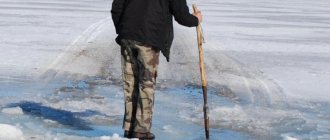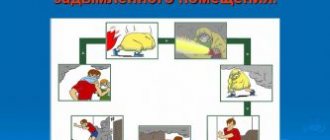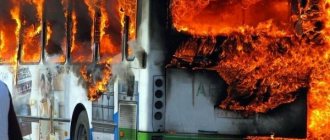Natural emergencies are dangerous due to their suddenness. Often the population panics, not knowing how to react in such a situation. This leads to an increase in the number of disaster victims.
The purpose of this article is to give the reader the necessary information regarding the rules of conduct during landslides, mudflows and landslides. You will learn what needs to be done in such a situation in order to save the lives of yourself and your loved ones.
Step-by-step actions of the population in case of landslides, landslides, mudflows
Some natural phenomena require a person to endure and perform a certain algorithm of actions to preserve his own life (Figure 1).
We will talk about emergency situations such as landslides, landslides and mudflows, which are characterized by suddenness and rapidity.
They can take us by surprise, causing panic and helplessness. Therefore, the population in dangerous areas should be well aware of what to do in each emergency situation.
So, the algorithm for action in case of collapses:
- Do not try to escape, the speed of collapse in the mountains is higher than human speed. It is better to try to move across the rockfall to its edge, where the intensity of traffic is less. Try climbing up onto a hill or tree.
- If you were unable to move to the side, throw aside any sharp and hard objects you have, roll in the direction of the collapse, trying to keep your muscles relaxed. Cover your head with your hands.
- Protect your respiratory system from sand and dirt with clothing.
- If a building collapses, try to position yourself under stable structures: walls, doorways. Do not use elevators or stairs.
- When the collapse stops, clear enough space around your face to allow oxygen to enter.
- To find your way under the rubble, spit through your teeth. If saliva gets on your face, it means you are upside down.
- Try to free the trapped limbs, try to move towards the surface or to a safer place. If there is a danger of repeated shedding, movement should be stopped.
- Scream and call for help, try to sing so that the rescuers hear you.
- Try not to panic. Wait for release by regularly checking the condition of your fingers and toes.
When notified of a rapidly approaching mudflow, act in the following sequence:
- Collect documents and money, prepare the necessary supply of food, water and medicine (bandage, antiseptic, painkillers).
- Turn off all electrical appliances, turn off the gas and water.
- Close windows, doors and vents tightly.
- Protect valuables that cannot be removed from dirt.
- Climb to higher ground to safety, being careful of rocks that may fly out of the mud flow.
- In case of danger, do not think about your property, save your life.
Having received information about a landslide or mudflow, you must be prepared for urgent evacuation:
- Collect documents, water and provisions.
- Act in accordance with the threat, which is determined by the speed of the landslide.
- At a low speed (meters per month), act according to your capabilities - remove furniture, things, move buildings, etc.
- If the displacement rate is more than 1 m per day, take action in accordance with a pre-developed plan.
- In case of urgent evacuation, turn off gas and electrical appliances and turn off the water.
Figure 1. Such spontaneous actions require organization from the population.
If necessary, take warm clothes, then move to a safe place as quickly and as organizedly as possible.
Actions in case of threat of landslides, landslides, mudflows and avalanches
Natural disasters have threatened the inhabitants of our planet since the beginning of civilization. Somewhere to a greater extent, somewhere to a lesser extent. Natural disasters can cause colossal damage, the amount of which depends not only on the intensity of the disasters themselves, but also on the level of development of society.
It is statistically calculated that in general on Earth every hundred thousand people die from natural disasters. According to another calculation, the number of victims of natural disasters in the last 100 years is 16 thousand annually. Natural disasters typically include earthquakes, floods, mudslides, landslides, snow drifts, volcanic eruptions, landslides, droughts, hurricanes and storms. In some cases, such disasters can also include fires, especially massive forest and peat fires.
In this work we will address the issue of competent behavior in the event of landslides, landslides, mudflows and avalanches. But first, let’s define the essence of these natural disasters.
Landslides are the sliding movement of rock masses down a slope under the influence of gravity.
Mudflows are rapid mud and mud-stone flows that suddenly appear in the beds of mountain rivers.
Landslides and mudflows most often occur due to excessive precipitation, rapid melting of snow and glaciers in the mountains, as well as insufficiently thought-out human activities, as a result of which the conditions of soil stability change (destruction of forests, excessive use of irrigation systems, etc.). ).
Landslides are the separation and rapid fall of large masses of rocks, their overturning, crushing and rolling down steep and steep slopes.
The direct danger of landslides, mudflows and collapses is the destruction of buildings and structures, electricity, gas, water supply and sewerage lines, death and injury to people.
Landslides and collapses usually accompany natural disasters such as floods, earthquakes and volcanic eruptions.
The initial sign of the onset of landslide movements is the appearance of cracks on buildings, gaps in roads, coastal fortifications and embankments, bulging of the earth, displacement of the base of various high-rise structures and trees in the lower part relative to the upper.
This is interesting: Search for a criminal case by number
The population living in landslide-, mudflow- and landslide-hazardous zones should know the sources, possible directions and main characteristics of these natural phenomena. Based on these forecasts, residents are informed in advance about the situation in the location of their settlement and enterprises regarding the identified landslide, mudflow, landslide sources and possible zones of their action, about the periods of passage of mudflows, as well as about the procedure for submitting signals about the threat of these phenomena. . Such early informing of people about possible sources of natural disaster prevents stress and panic that may arise later when transmitting emergency information about the immediate threat of these phenomena.
The population of these dangerous mountainous areas is also obliged to take measures to strengthen houses and the territories on which they are built. Also, participate in the construction of protective hydraulic and other engineering structures that protect against landslides and mudflows.
Active measures to prevent landslides, mudflows, and landslides include the construction of engineering and hydraulic structures. To prevent landslide processes, retaining walls, counter-banquets, pile rows and other structures are constructed. The most effective anti-landslide structures are counter-banquets. They are located at the base of a potential landslide and, by creating a stop, prevent the soil from moving.
Active measures also include fairly simple ones that do not require significant resources or consumption of building materials for their implementation, namely:
- v To reduce the stressed state of slopes, earth masses are often cut off in the upper part and laid at the foot;
- v Groundwater above a possible landslide is removed by installing a drainage system;
- v Protection of river and sea banks is achieved by importing sand and pebbles, and slopes by sowing grass, planting trees and shrubs.
Hydraulic structures are also used to protect against mudflows. Based on the nature of their impact on mudflows, these structures are divided into mudflow control, mudflow dividing, mudflow retention and mudflow transforming structures.
The mudflow control hydraulic structures include mudflow passages (chutes, mudflow diversions, mudflow diversions), mudflow control devices (dams, retaining walls, rims), mudflow release devices (dams, thresholds, drops) and mudflow control devices (half-dams, spurs, booms) constructed in front of dams, rims and retaining structures. walls.
Cable mudflow cutters, mudflow barriers and mudflow dams are used as mudflow dividers. They are installed to retain large fragments of material and allow small parts of the debris flow to pass through.
Mudflow-retaining hydraulic structures include dams and pits. Dams can be blind or with holes. Blind-type structures are used to retain all types of mountain runoff, and with holes - to retain the solid mass of mudflows and allow water to pass through.
Mudflow-transforming hydraulic structures (reservoirs) are used to transform a mudflow into a flood by replenishing it with water from reservoirs.
It is more effective not to delay mudflows, but to direct them past populated areas and structures using mudflow diversion channels, mudflow diversion bridges and mudflow drains.
In landslide-prone areas, measures can be taken to move individual sections of roads, power lines and objects to a safe place, as well as active measures to install engineering structures - guide walls designed to change the direction of movement of collapsed rocks.
Along with preventive and protective measures, an important role in preventing the occurrence of these natural disasters and in reducing damage from them is played by monitoring landslide, mudflow and landslide-prone areas, harbingers of these phenomena and predicting the occurrence of landslides, mudflows and landslides.
Observation and forecasting systems are organized on the basis of hydrometeorological service institutions and are based on thorough engineering-geological and engineering-hydrological studies. Observations are carried out by specialized landslide and mudflow stations, mudflow batches and posts. The objects of observation are soil movements and landslide movements, changes in water levels in wells, drainage structures, boreholes, rivers and reservoirs, groundwater regimes. The obtained data characterizing the preconditions for landslide movements, mudflows and landslide phenomena are processed and presented in the form of long-term (years), short-term (months, weeks) and emergency (hours, minutes) forecasts.
Primary information about the threat of landslides, mudflows and avalanches comes from landslide and mudflow stations, parties and hydrometeorological service posts. It is important that this information is communicated to the population in a timely manner. Notification of these natural disasters is carried out in the prescribed manner through sirens, radio and television broadcasting, as well as using local warning systems that directly connect the hydrometeorological service unit with the populated area located in the threat zones.
If there is a threat of a landslide, mudflow or landslide, and if there is time, advance evacuation of the population, farm animals and property from the threat zones to safe places is organized.
Before leaving a house or apartment for early evacuation, it is necessary to put them in a state that helps to weaken the damaging factors of a natural disaster, prevent the occurrence of secondary factors and facilitate subsequent possible excavations and restoration. To do this, all portable property from the yard or balcony must be removed into the house; the most valuable property that cannot be taken with you must be protected from moisture and dirt. Doors, windows, ventilation and other openings are tightly closed. Electricity, gas, and water supply are turned off. Flammable and toxic substances are removed from the house and, if possible, buried in remote pits or separate cellars. In all other respects, citizens act in accordance with the procedure established for organized evacuation.
If there was no advance warning of the danger, and residents were warned about the threat immediately before the onset of a natural disaster or noticed its approach themselves, each of them, without worrying about property, makes an emergency independent exit to a safe place. At the same time, relatives, neighbors, and all people encountered should be warned about the danger.
For an emergency exit, you need to know the routes to the nearest safe places. These paths are determined and brought to the attention of the population in advance based on the forecast of the most likely directions of arrival of a landslide (mudflow) to a given settlement (object). Natural safe places for emergency exit are the slopes of mountains and hills that are not prone to landslide processes, or between which there is a mudflow-hazardous direction. When climbing to safe slopes, valleys, gorges and recesses should not be used, as side channels of the main mudflow may form in them. On the way, assistance should be provided to the sick, elderly, disabled, children, and the weak. For movement, if possible, personal transport, mobile agricultural machinery, riding and pack animals are used.
This is interesting: Amnesty for traffic police fines 2021
In the event that people, buildings and other structures find themselves on the surface of a moving landslide area, you should leave the premises, move upward if possible and, acting according to the situation, beware when braking the landslide of blocks, stones, fragments of structures, an earthen rampart rolling down from its rear part, scree. When stopping, the frontal zone of the landslide can be crushed and heaved. It can also take over the thrust of immovable rocks. At high speeds, a strong shock is possible when stopping the landslide. All this poses a great danger to people in the landslide.
After the end of a landslide, mudflow or landslide, people who had previously hastily left the disaster zone and waited out it in a nearby safe place should make sure that there is no repeat threat and return to this zone. Bearing in mind that outside help will arrive late in hard-to-reach mountainous areas, they must immediately begin searching for and extracting victims, providing them with first aid, freeing vehicles from the blockade, localizing possible secondary negative consequences, and reporting what happened.
The population and territory of the Earth with numerous economic objects are subject to the negative impacts of more than 50 dangerous natural and man-made processes.
Depending on the specific natural and climatic conditions and heliophysical factors of each year (or series of years), the risk of some of them increases and the risk of others decreases.
In 2001, there was a trend towards a decrease in the number of natural disasters and emergencies of a natural nature on the territory of the Russian Federation. For example, in 11 months of 2001, 186 natural emergencies occurred, while in 1998, 1999 and 2000. they were observed in 465, 263 and 282 emergencies, respectively. This positive trend is caused by both natural and socio-economic reasons, consisting in the progressive development of the Russian economy in the last 3 years and an increase in spending on current and capital protective measures.
Danger and negative consequences
The danger of the described emergency phenomena consists in impacts of rocks and stones, large blocking of open space with rock masses, and a risk to human life (Figure 3).
Among the negative consequences of these emergencies are the destruction of roads, highways and communications (pipes for supplying water, gas and electricity). Combined with the destruction of houses and even the complete destruction of populated areas, this natural disaster poses a serious danger to the population.
Figure 3. The danger of landslides is that they completely destroy all objects in their path
In addition, landslides, landslides and mudflows provoke modifications of the landscape - changes or blocking of river beds, swamping of fertile lands, destruction of agricultural plantings, which is often accompanied by the death of people and animals.
How to behave during an avalanche
An avalanche is a huge mass of snow falling from the slopes of mountains at high speed (90-100 km/h). This natural phenomenon can cause serious destruction, being the most dangerous for people who are on the slope at this time (Figure 4).
In some cases, an avalanche poses a danger to residents of populated areas along its path. In this case, the actions of the population will be similar to the behavior during landslides: you need to close windows and ventilation openings, cut off all communications in the house and, taking with you only the most necessary things, evacuate to a safe place.
Once caught in an avalanche, a person is susceptible to many injuries and may die from suffocation. That is why climbers and skiers should study the terrain and weather forecast before going on a hike.
If you do find yourself in the center of a natural disaster, proceed as follows:
- If possible, try to get out of the way of the avalanche to a safe place (behind a rock ledge, into any recess). If this is not possible, free yourself from things, take a horizontal position in the direction of movement of the avalanche, pull your knees to your stomach.
- Protect your mouth and nose with a scarf, mitten, or collar.
- When moving in an avalanche, try to stay on its surface and move with smooth swimming movements to the edge of the avalanche.
- Do not shout under any circumstances. The snow completely muffles all sounds, and meaningless movements deprive you of oxygen, strength and warmth. Make a sound only when you feel someone is nearby.
- When the avalanche stops, break the ice crust on your face that has formed as a result of breathing. Create some space around your face and chest, which will help with breathing.
Figure 4. This is what you should do if you are caught in an avalanche.
If the opportunity presents itself, move to the top of the avalanche. You can determine the direction of movement using saliva, simply by allowing it to flow out of your mouth. Under the force of gravity it will fall down.
Rules of conduct during a mudflow
1. During early evacuation:
turn off electricity, gas and water supply; close doors, windows and vents tightly; go out to the indicated area.
2. In case of emergency evacuation:
quickly leave the house and climb the nearest mountain slopes or hills. At the same time, avoid gorges and lowlands, since they can form a side channel of the main mudflow.
This is interesting: The duties of an investigator in the Ministry of Emergency Situations
3. If a mudflow suddenly approaches:
climb up the slope as quickly as possible, throwing off all heavy things and clothing that would impede rapid movement. If you don’t have time for this, climb a powerful tree that stands away from the main stream.
Remember! Unstable rocks, steep slopes and weak trees can be dangerous as mudflows can wash them away.
4. If a person is caught by a moving mud flow, it is necessary to help him by extending a pole, throwing a rope or rope.
Ways to combat landslides, mudflows and landslides.
Measures to prevent landslides, mudflows, and landslides include the construction of engineering and hydraulic structures. Retaining walls, counter-banquets, pile rows and other structures are being constructed. The most effective anti-landslide structures are counter-banquets (placed at the base of a potential landslide)
Active measures also include fairly simple ones that do not require significant resources or consumption of building materials for their implementation, namely:
ü to reduce the stressed state of slopes, land masses are often cut off in the upper part and laid at the foot;
ü groundwater above a possible landslide is drained by installing a drainage system;
ü protection of river and sea banks is achieved by importing sand and pebbles, and slopes by sowing grass, planting trees and shrubs.
Hydraulic structures are also used to protect against mudflows:
ü mudflow control ( mud flow
(troughs, seleduks, mudflow diversions),
mudflow guides
(dams, retaining walls, rims),
mudflow release devices
(dams, thresholds, drops) and
mudflow control
(half-dams, spurs, booms) devices in front of the dams);
ü mudflow dividers (cable mudflow cutters, mudflow barriers and mudflow dams).
ü mudflow retention (dams and pits).
In landslide-prone areas, measures may be taken to relocate objects.
Monitoring of landslides, mudflows and collapse-prone areas.
Rules of behavior for people in the event of mudflows, landslides and landslides.
The population should know the sources, possible directions and characteristics of these dangerous phenomena.
Based on forecasts, residents are informed about the danger in advance.
The population of dangerous mountainous areas is obliged to take care of strengthening their houses and territory.
Warning the population about natural disasters.
If there is a threat of a landslide, mudflow or collapse, early evacuation of the population is organized.
ü moved property from the yard or balcony must be removed into the house,
ü the most valuable thing that cannot be taken with you, protected from moisture and dirt.
ü close doors, windows, ventilation and other openings tightly.
ü Turn off electricity, gas, and water supply.
ü Remove flammable and toxic substances from the house and place them in remote pits or separate cellars.
ü act in accordance with the procedure established for organized evacuation.
· For an emergency exit, you need to know the routes to the nearest safe places.
· Natural safe routes for emergency exit from the danger zone are the slopes of mountains and hills, which are not prone to landslides.
· When climbing to safe slopes, do not use valleys, gorges and recesses, since side channels of the main mudflow may form in them.
· On the way, assistance should be provided to the sick, elderly, disabled, children and the weak.
· Whenever possible, personal transport, mobile agricultural machinery, riding and pack animals are used for transportation.
In the event that people and structures find themselves on the surface of a moving landslide
area, you should move upward if possible, beware of rolling blocks, stones, debris, structures, earthen ramparts, and screes. When the landslide speed is high, a strong shock is possible when it stops, and this poses a great danger to people.
After the end of a landslide, mudflow or collapse, people who had previously hastily left the disaster zone and waited out the danger in the nearest safe place, making sure that there is no repeated threat, should return to this area to search for and provide assistance to the victims.
What to do in case of mudflows
As a rule, places prone to debris flows are well known. Therefore, if you are going to the mountains, study your route first (Figure 6).
If the weather service warns of heavy rainfall or intense snow melting, take into account the possibility of a mudflow and do not go to the mountains in bad weather. There is practically no chance of escape if you get into a mudflow, but encountering it can be avoided.
When you hear a roar, immediately rise up from the lowland, at least 100 meters, staying away from river beds and streams.
The population living in dangerous areas should be prepared to evacuate when notified of a mudflow. You need to collect documents, take money and medicine, a small supply of water and food. When leaving the house, turn off the gas and electricity, close the windows and doors tightly. In case of a quick evacuation, move to a safe place on higher ground, helping physically weaker people.
Figure 6. It is almost impossible to get out of a mudflow, so you need to do everything possible to avoid encountering it.
At the same time, you need to know that stones that threaten life can be thrown from a moving stream over long distances. If you are injured as a result of an emergency, try to provide yourself with first aid by applying ice (wet cloth) or a pressure bandage to the affected areas of your body. If possible, provide assistance to the victims around you, assist in the removal of rubble and drifts along the path of the flow.











